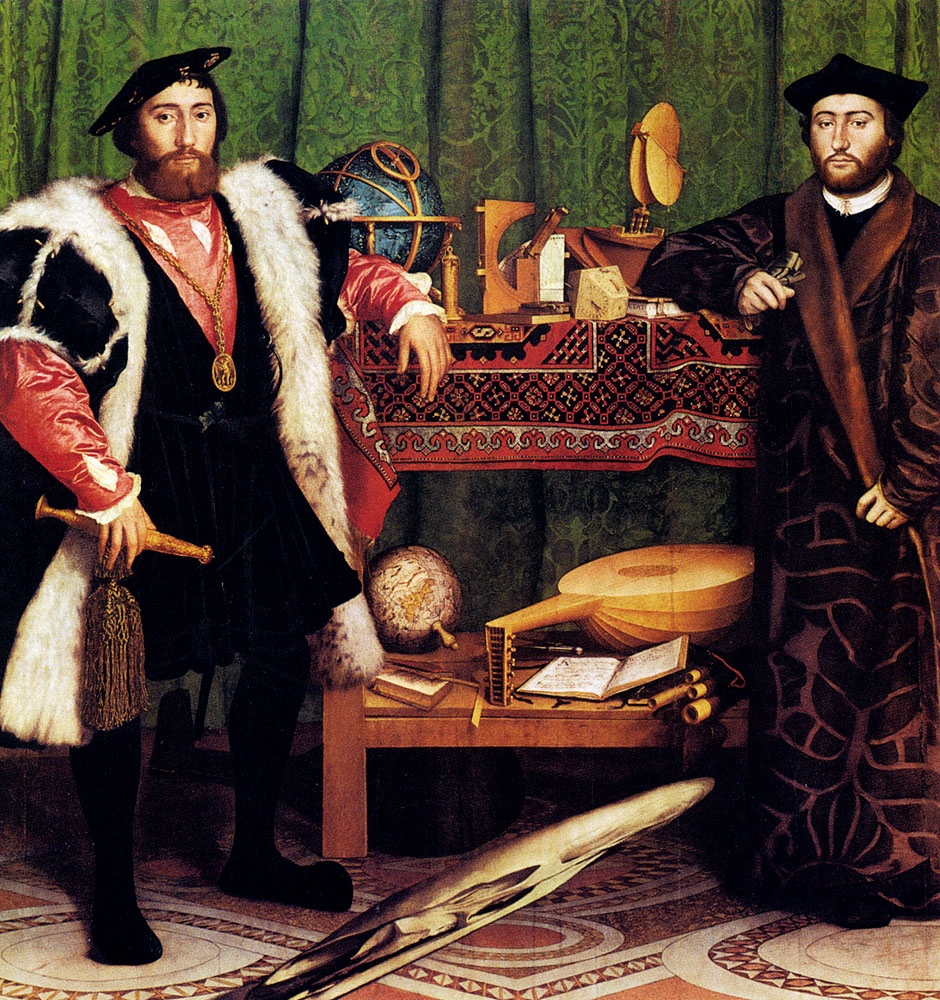Phenomenology
Abigail Matses

Figure 1. Hans Holbein the Younger, The French Ambassadors, 1533. Oil on canvas. The National Gallery, London
Phenomenology is the philosophical study of how things appear, how individuals experience those things, and the meaning of those experiences in the perceiver’s consciousness.
Philosopher Maurice Merleau-Ponty applied the concept to the study of art in Cezanne’s Doubt (1945). Merleau-Ponty explored the role perception played in Cézanne’s works, describing how the artist’s distortions captured shifting objects in the act of appearing. When one extrapolates Merleau-Ponty’s ideas, phenomenology becomes a way of understanding how two-dimensional visual production acts upon the consciousness of the viewer.
Linear perspective serves as a valuable starting point to problematize phenomenological experience. Painters convey a sense of “rationalized space” by using such methods as single-point perspective to depict three-dimensional forms on a two-dimensional canvas.1 Because phenomenology inherently relies upon multiple interpretations – and thus, varied lived and embodied perspectives – the rigid practice of single-point linear perspective fails to visually convey the complexity of phenomenological approaches to painting. The idea that there is only one single manner to translate the reality of a three-dimensional world into a two-dimensional surface omits the multiplicity of viewpoints and therefore erases the plurality of viewers’ phenomenological experiences.
Seventeenth-century friar Jean-Francois Niceron (1613-1646) rectified this theoretical shortcoming through anamorphosis — an intentionally distorted perspectival construction — as explained in his 1638 book La Perspective Curieuse. In anamorphic explorations, the artist acts as a philosopher, purposefully skewing parts of the composition in order to make the viewer aware of multiple paths of perception.2 Consequently, a painting containing an anamorphic distortion allows phenomenology as a critical concept to find a concrete visual articulation. Hans Holbein the Younger’s The French Ambassadors (1533) is an ideal example of such a work.
In The French Ambassadors, phenomenological theory and visual representation of these theories find a mutually reinforcing expression. Most of the canvas on The French Ambassadors adheres to the type or linear perspective systematized by Leon Battista Alberti’s fifteenth-century treatise. However, this single point perspective takes for granted a viewer’s fixed viewpoint and “hypothetical distance from the picture plane.”3 For this reason, linear perspective is unsatisfactory in terms of conveying actual reality since humans do not naturally view the world as a unique object to be translated in a single manner. Humans have an experiential viewing process that includes constantly changing viewpoints: scanning up, around, over, and under to get a fuller understanding of what it is they are seeing. In The French Ambassadors, Holbein the Younger acknowledges this by incorporating an anamorphic skull at bottom center that jars the viewers and allows them to recognize the need to view the painting from different angles in order to see the entirety of the composition — anamorphic skull included — thereby counting on the plurality of phenomenological experiences to fully activate the meaning of the painting.
Jean-Francois Niceron believed that anamorphosis was the answer to the phenomenological problem posed by linear perspective, and developed a perspectival mathematical formula to produce anamorphic images that “capitalized on the ambiguity” of existing vanishing-point methods.4 Anamorphic images manipulate the vanishing point so that the “ideal viewpoint is no longer opposite the presumed central view.”5 The anamorphic object can only be properly seen from an alternative viewing position, forcing the viewer to physically shift his/her position as an expression of the shifting of his/her experiential viewpoint.
The visual components in The French Ambassadors “acknowledge a contradiction between inhabiting space and picturing it.”6 By offering the viewer more than one viewpoint, The French Ambassadors acts as an intermediary for the viewer, visually signaling an “added dimension” or alternate means of perception, and thus inviting an elegant way for the art historian to both apply and resolve the problems posed by phenomenology as a critical concept.
